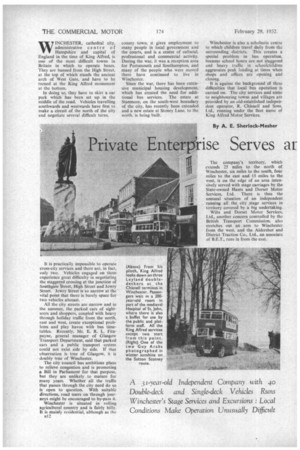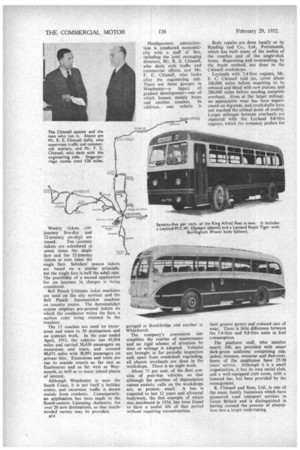Private Enterprise Serves ar ancient City
Page 46

Page 47

Page 48

If you've noticed an error in this article please click here to report it so we can fix it.
By A. E. Sheriock-Mesher
WINCHESTER, cathedral city, administrative centre of Hampshire and capital of England in the time of King Alfred, is one of the most difficult towns in Britain in which to operate buses. They are banned from the High Street, at the top of which stands the ancient arch of West Gate, and have to be turned at the King Alfred monument at the bottom.
In doing so, they have to skirt a car park which has been set up in the middle of the road. Vehicles travelling southwards and westwards have first to make a circuit of the north of the city and negotiate several difficult turns.
ills practically impossible to operate cross-city services and there are, in fact, only two. Vehicles engaged on them experience great difficulty in negotiating the staggered crossing at the junction of Southgate treet, High Street and Jewry Street, -Jewry Streetis so narrow at the vital point that there is barely space for two vehicles abreast.
All the city streets are narrow and in the summer, the parked cars of sightseers and shoppers, coupled with heavy through holiday traffic from the north, east and west, create exceptional problems and play havoc with bus timetables. Recently, Mr. E. R. L. Fitzpaync, general manager of Glasgow Transport Department, said that parked cars and a public transport system could not exist side by side. If that observation is true of Glasgow, it is doubly true of Winchester.
The city council has ambitious plans to relieve congestion and is promoting a Bill in Parliament for that purpose, but they are unlikely to mature for many years. Whether all the traffic that passes through the city need do so is open to question. With suitable directions, road users on through journey§ might be encouraged to by-pass it.
Winchester is situated in rolling agricultural country and is fairly hilly. It is mainly residential, although as the county town, it gives employment to many people in local government and the courts, and is a centre of cultural, professional and commercial activity. During the war, it was a reception area for Portsmouth and Southampton, and many of the people who were moved there have continued to live in Winchester.
Since the war, there has been extensive municipal housing development, which has created the need for additional bus services. The estate at Stanmore, on the south-west boundary of the city, has recently been extended and a new estate at Stoney Lane, to the north, is being built.
Winchester is also a scholastic centre to which children travel daily from the surrounding districts, This creates a special problem in bus operation, because school hours are not staggered and heavy traffic in schoolchildren aggravates peak loading at times when shoPs and offices are opening and closing.
It is against the background of these difficulties that local bus Operation is carried on. The city Services and some to neighbouring towns and villages are provided by an old-established independent operator, R. Chisnell and Sons, Ltd., running under the fleet name of King Alfred Motor Services.
The company's territory, which extends 25 miles to the north of Winchester, six miles to the south, four miles to the east and 15 miles to the west, is on the edge of an area intensively served with stage carriages by the State-owned Hants and Dorset Motor Services, Ltd. There is thus the unusual situation of an independent running all the city stage services in territory covered by a big undertaking. Wilts and Dorset Motor Services. Ltd., another concern controlled by the British Transport Commission, also stretches out an arm to Winchester from the west, and the Aldershot and District Traction Co., Ltd., an associate of BET., runs in from the east.
The Chisnell and Hants and Dorset organizations both began running .stage services in Winchester at about the same time some 30 years ago,although the''late Mr. R. Chisnell started public transport in 1915. Winchester was a main centre for troops during the 191418 war, and to meet the need for transport between the neighbouring camps and the city, Delaunay-Belleville cars were pulchased and converted into 12-seat shooting brakes. These vehicles operated a regular service until 1919. In that year, coach tours were started with reconditioned R.A.F.-type Leylands with 28-seat ehar-a-bancs bodies.
The new housing estate at Statunore saw the-first-stage service to be run in 1921. In that year two-hourly services were also inaugurated to Shawford, Twyford and Flowerdown, recondit inned R.A.F.-type Leylands with saloon bus bodies being used. During the years that followed, other services were started to OutlYiht districts and the local services were consolidated.
The fleet now comprises 40 vehicles, of which 27 are buses and 13' coacheS.
The 21 Leyland buses corn/vise 12Titan double-deckers; and five Lion, three Tiger and one Leyland-M.C.W. Olympic single-deckers. The other buses are two Guy Arabs, two Albions and two Bedfords.
The eight Leyland coaches 'comprise five Tigers, two -Comets and a new Royal Tiger underfloor-engined 39: seater with 'Burlingham body, The coach fleet is completed by three Alhions and two Bedford-Duple Vistas.
Just as the war of 1914-18 created tleSA' 'public demands, so the 1939-45 war has left permanent impressions on publie transport in Winchester. A' heavy increase in traffic caused double-deckers to be introduced by the Chisnell con
cern in 1941. Their presence in itself created more traffic and the business could not now be run economically without them. Some of the latest Leyland double-deckers have folding doors and are thus Completely acceptable for use by large private parties, even in the winter.
Thirteen stage-carriage routes, having a total mileage of 120, are operated,' The length of the shortest is two miles and of the longest 24 miles. Frequencies vary between 10 minutes on local services and three to four hours on country routes.
The cross-city services mentioned earlier link the housing estates at Stanmore and Stoney Lane. They are worked with single-deckers because of the presence of two low bridges, although traffic would justify the employment of double-deckers.
There are three daily peaks, one inwards from 7 a.m. to 9 a.m.. another smaller one from noon to 2 p.m.. and a third, outwards, from 4 p.m. to 6 p.m. The midday peak is two-way. At these periods every bus and crew are pressed into service. Like other operators, however, the company is short of staff.
Stage-carriage work comprises the bulk of the company's operations. Of the 4,653,603 passengers carried in the year ended April', 1951, 4,584,282 travelled by bus over a distance ol 996,905 miles. The load factor was thus 4.7 passengers per mile.
After offices and shops have closed in the evening, Winchester is "dead," but buses still have to run, which makes operation expensive. Nevertheless, fares have been raised only once since stagecarriage work began in 1921. The increase took effect in January, 1951.
On short town services, fares still average less than 1d. 'a mile. The minimum is 11d. and the maximum single fare (Winchester-Basingstoke) is 2s. 3d. The corresponding return is 3s.4d.-There is no standard fare structure, because, like those of most bus companies, rates vary according to traffic density.
Weekly tickets (10journey five-day and 12-journey six-day) are issued. Ten-journey tickets are calculated at seven times the single fare and the 12-journey tickets at nine times the single fare. Scholars' season tickets are based on a similar principle, but the single fare is half the adult rate. The possibility of a second application for an increase in charges is being considered.
Bell Punch Ultimate ticket machines are used on the city services and the Bell Punch Automaticket machine on country routes. The Automaticket system employs pre-printed tickets tin which the conductor writes the fare, a carbon copy being retained in the machine.
The 13 coaches are used on excursions and tours to 50 destinations and on contract work. In the year ended April, 1951, the vehicles ran 45,954 miles and carried 30,430 passengers on excursions and tours, and covered 40,671 miles with 38,891 passengers on private hire. Excursions and tours are run to seaside resorts as far east as Eastbourne and as far west as Weymouth, as well as to many inland places of interest.
Although Winchester is near the South Coast, it is not itself a holiday centre, and excursion traffic is drawn mainly from residents. Consequently, an application has been made to the South-eastern Licensing Authority for over 20 new destinations, so that muchneeded variety may be provided.
Headquarters administration is conducted economically with a staff of five, including the joint managing directors, Mr. R. E. Chisnell, who deals with traffic and commercial affairs, and Mr. F. C. Chisnell, who looks after the engineering side. There are three garages in Winchester—a legacy of gradual development—one of which houses mainly buses and another coaches. In addition, one vehicle is garaged at Stockbridge and another at Whitchurch.
The company's convenient size simplifies the routine of maintenance and no rigid scheme of attention by time or mileage is adopted. Vehicles are brought 1 in for periodic inspection and, apart from crankshaft regrinding, all chassis overhauls are done in the workshops. 1There is no night work.
About 75 per cent, of the fleet consists of post-war vehicles, so that although the problem of depreciation causes anxiety, calls on the workshops are, at present, small. A bus is expected to last 12 years and all-metal bodywork, the first example of which was purchased in 1934, has been found to have a useful life of that period without reqairing reconstruction. Body repairs are done locally or by Reading and Co., Ltd., Portsmouth, which has built many of the bodies of the coaches and of the single-deck buses. Repainting and revarnishing, by the brush method, are done in the Chisnell workshops.
Leylands with 7.4-litre engines, Mr. F. C. Chisnell told me, cover about 100,000 miles before requiring to be rebored and fitted with new pistons, and 200,000 miles before needing complete overhaul. Even at the larger mileage, no appreciable wear has been experienced on big-ends, and crankshafts have not reached the critical point of ovality. Larger mileages between overhauls are expected with the Leyland 9.8-litre engines, which the company prefers for their greater power and reduced rate of wear. There is little difference between the 7.4-litre and 9.8-litre units in fuel consumption.
The platform staff, who number nearly 100, are provided with smart dark-green uniforms comprising cap, jacket, trousers, overcoat and dust-coat. Some of the employees have 25-30 years' service. Although it is a small organization, it has its own social club, and a well-equipped club room, with a licensed bar, has been provided by the management.
R. Chisnell and Sons, Ltd., is one of the many family businesses which have pioneered road transport services in Great Britain and is distinguished in .having resisted the process of absorption into a larger undertaking.




















































































